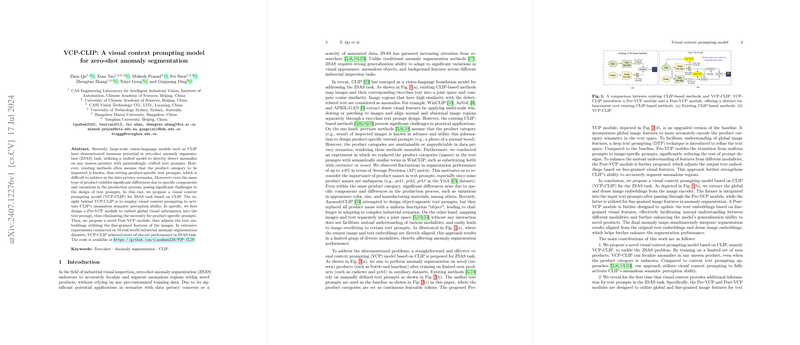Insightful Overview of "VCP-CLIP: A Visual Context Prompting Model for Zero-Shot Anomaly Segmentation"
The paper, titled "VCP-CLIP: A Visual Context Prompting Model for Zero-Shot Anomaly Segmentation," introduces a novel approach to anomaly segmentation utilizing vision-LLMs, specifically targeting zero-shot tasks. The baseline of the paper is built upon CLIP, a prominent vision-LLM, which provides the foundation for the development of VCP-CLIP. The authors aim to address two primary challenges in zero-shot anomaly segmentation (ZSAS): the dependency on tailor-made text prompts, and the necessity of prior knowledge of product categories during inspection.
Core Contributions
The central innovation of this research is the introduction of Visual Context Prompting (VCP), which bridges the gap between visual inputs and their corresponding textual representations in zero-shot scenarios. The paper details the implementation of VCP through two distinct modules:
- Pre-VCP Module: This module integrates global image features directly into the textual prompts. By replacing the need for product-specific prompts, it effectively synthesizes visual inputs into the text, thereby eliminating the requirement of foreknowledge about a product's category.
- Post-VCP Module: By refining text embeddings using fine-grained image features, this module ensures that the model is capable of understanding cross-modal semantic associations more effectively, which enhances the precision of anomaly localization.
Performance Evaluation
The VCP-CLIP strategy demonstrates notable improvements over existing methodologies. Presented results in the paper show that the model surpasses state-of-the-art performances across multiple industrial datasets, including MVTec-AD, VisA, and others, in terms of AUROC, PRO, and Average Precision (AP). On the VisA dataset, for instance, VCP-CLIP achieves an AUROC score of 95.7%, and an AP score of 30.1%, indicating a robust capacity to segment anomalies even in complex visual scenes with fine detail.
Implications and Future Directions
The introduction of VCP-CLIP carries significant practical implications. By reducing the reliance on manually designed prompts and removing the need for product categorizations, this research embodies a step toward more generalized and adaptable machine vision systems. Such advancements hold potential benefits across various fields, including industrial inspection and quality control, where diverse and unseen data frequently appear.
Theoretically, the modular design of Pre-VCP and Post-VCP contributes to the ongoing dialogue in vision-language integration, providing insights that may inform future research in multimodal learning. The focus on cross-modal understanding emphasizes the growing importance of visual context in enhancing LLM capabilities.
Future work could investigate the scalability of VCP-CLIP across different contexts, especially considering the issues of over-detection in minor anomalies and potential cross-domain adaptations. Moreover, subsequent research might explore the integration of fine-grain learning techniques or ensemble methods to further bolster model resilience and adaptability in diverse operational environments.
In summary, this paper presents a methodologically sound and technically advanced approach to zero-shot anomaly segmentation, offering substantial contributions to both academic research and practical applications in AI.
